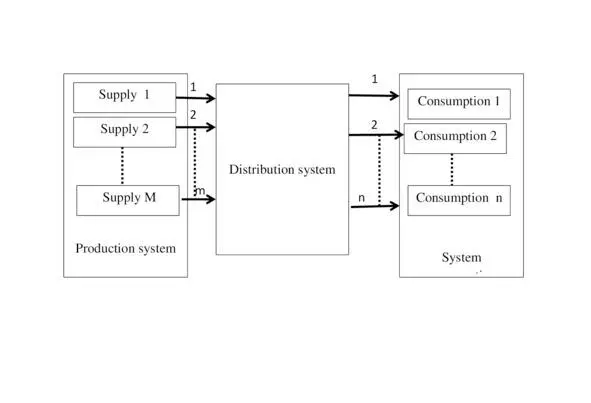Flow of goods (offer) in mathematical models, often adopted as the simplest flow, flow of Palm or primitive. In these cases it is relatively easy to obtain the solution of the problem using analytical methods.
Real flows of goods have a more complex structure, and the decision of task is usually carried out according results received for the simplest stream in the form of the boundary estimates of indicators (results for simplest stream better or worse).
The most convenient distribution function of service time from the point of view of the analytical description and analysis of the throughput of the market is the exponential distribution, since it has no aftereffect.
Practical widely application founds probability distributions – density distribution, Erlang distribution etc.
Discipline of service has a significant impact on the mathematical model of the market, therefore it is necessary to describe in great detail. For example, in the system with the expectation of the accumulated goods may be return from storage back on market:
– in order of receipt;
– in the reverse order of the order of arrival;
– random order;
– with different kinds of priorities.
Traffic-carrying capacity market of consumer groups may be estimated the ratio of intensity a serv of supplies of goods υwhat was serviced.
η =a 0/ υ,
The value η is called the average traffic-carrying capacity market, or average utilization of one group of consumers.
For example, in one people can buy 400 kg of milk per year. By delivery to the dairy market in 1991, was sold to 347 kg of milk per person per year, η = (347/400=0.8675), and in 2014 sold 240 kg of milk per person per year (η =240/400=0.6) [4.5]. Therefore, the capacity of the dairy market fell by 26%/
The capacity market can be analyzed from the point of view of arriving of the supply η =f (y) or in terms of a number of consumer groups η = f ( υ ) ) at fixed values of losses.
The value of η by increasing the intensity of the incoming of supply asymptotically approaches unity. This is due to the decrease in the influence of temporary fluctuations of demand. This property shows the usefulness of combining groups of consumers (larger market), which reduces these oscillations.
1. The intensity of the supply of goods is it_________
a. the number of calls per unit of time
b. the total duration of calls per unit of time
c. the demand of products per unit time
d. amount of goods that passed system
2. Serviced market offer for time period (t 1, t 2) is it_________
a. the number of products sold over time (t 1, t 2)
b. the difference between the received and a serviced supply of goods for
the considered period of time.
c. the sum of the quantities of goods handled by this group
consumers for the period (t 1, t 2)
d. the sum of the requirements for a certain number of goods, served during (t 1, t 2)
3. The unit of measure of the intensity of demand of the goods is accepted _________
a. the number of purchases per hour
b. the relative value of consumption at the maximum consumption (Preal= Pmax) per unit time.
c. the amount of goods delivered
d. the amount of applications received for the goods
4. The time of greatest demand – THD _________
a. time of the season with the highest demand
b. time from sampling successive periods of time with maximum load
c. time of maximum demand for each month
d. continuous given period of time, with a maximum value of the intensity of demand
5.The main parameters of the demand are: __________
a. the number of consumer groups -n; the average number of bids on the goods unit of time; the average duration of consumption of service the one application t.+
b. the number of consumer groups -n; the average number of bids on the goods, price per time unit; price per unit;
c. the quantity of the goods; the average number of bids on the goods, price per unit of time; the average duration of consumption of service the one application t.
d. the number of consumers is n; the number of served requests for goods; the average duration of consumption of service the one application t.
6. When overproduction of goods and lowering the prices of the goods the number of consumers ______
a. increases
b. reduced
c.do stabilize
7. The average number of requests from one consumer per unit time from the k groups of consumers is determined by ______,
a.. according the group with a large number of requests
b. according the weighted average number of
c. according the most frequently used number
d. randomly
8. The time consumption of the goods can be _________ time of possession
a. equally
b. less
c. more
d. dependent on the storage conditions
9. Under a traffic-carrying capacity market we will understand the value. ________
a. intensity serviced supplies for a certain period of time when a certain amount of losses
b. intensity serviced supplies for a certain period of time
c. the amount of goods sold over a certain period of time
d. the number of applications for a certain product for a certain period of time
10. The more allowable are losses, then_________
a. less a traffic-carrying capacity market and the worse the quality services for producers
b. more a traffic-carrying capacity market and the worse the quality of service manufacturers
c. better quality of service manufacturers
d. stable quality maintenance of producers
11. A traffic-carrying capacity market is estimated —
.a number of consumers
b. value of losses
c. relation the intensity of services supply to the number of groups of consumers
d. number of suppliers
Chapter 2. A mathematical model of the market
For the mathematical estimate of processes in the economy it is necessary to create a model that would reflect them in mathematical form. In conjunction with the definition of units of measure of supply, demand and also definition of relative consumption, this model allows to obtain and to provide a quantitative calculation, analysis and give assessment of possible market behavior. The proposed model is shown in Fig.2.1.

Figure 2.1.A mathematical model of the market
The market contains a subsystems they performs the following tasks.
Production system – generates a random flow of goods (in general case different from each other). Under the product refers to any product or a service offered for sale, in which there is a need (in the following we will show how to define the demand in numerical form). These can be food items such as milk and other food products, cars, homes, cleaning home, stocks, services in construction of houses, etc.
The flow enters the distribution system.
The distribution systemcan the request handle immediately or with some delay. The refusal can be of two types:
– the refusal to accept the goods because of lack of demand;
– or installation on waiting of implementation (accumulation of goods);
There are two types of distribution systems.
The first of these it is the task as quickly as possible to sell the goods without any additional conditions. In queuing theory, such a system service is called “full accessibility system”because it provides equal access to the system of consumption, and this system can be not take into account for calculation of behavior of the market.
Читать дальше













